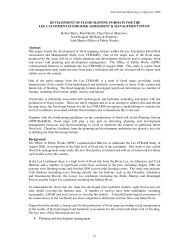Vegetation (Floating River Vegetation) - Office of Public Works
Vegetation (Floating River Vegetation) - Office of Public Works
Vegetation (Floating River Vegetation) - Office of Public Works
You also want an ePaper? Increase the reach of your titles
YUMPU automatically turns print PDFs into web optimized ePapers that Google loves.
4.4 Physical, chemical and biological features <strong>of</strong> watercourses with floating river vegetation.<br />
A review <strong>of</strong> Irish and international reports was undertaken to obtain an overview <strong>of</strong> the<br />
physical, chemical and biological characteristics associated with watercourses supporting floating<br />
river vegetation. Measures to create a greater awareness <strong>of</strong> the causes and threats to habitat<br />
destruction along with conservation, management and rehabilitation regimes are documented.<br />
Studies in the United Kingdom based on watercourse characteristics and the floating river<br />
vegetation found has been classified into six potential aquatic vegetation groupings (Hatton-Ellis &<br />
Grieve, 2003). Although the survey included protected and non-protected aquatic vegetation, non-<br />
protected species have been abstracted and a summary <strong>of</strong> the classes and protected floating river<br />
species are listed in Table 19.<br />
Group <strong>River</strong> Characteristics <strong>Floating</strong> river vegetation<br />
1 Large lowland rivers, slow flowing, river bed<br />
<strong>of</strong> silt or clay<br />
2 Small lowland rivers, bedrock is chalk and<br />
oolitic limestone, river bed consists <strong>of</strong> sand,<br />
gravel and stones<br />
3 Large river more than 20m wide <strong>of</strong> variable<br />
flow, bedrock <strong>of</strong> sandstone or hard limestone,<br />
alkaline, fair to nutrient rich<br />
4 <strong>River</strong> or streams usually tributaries <strong>of</strong> large<br />
rivers, variable <strong>of</strong> geological bedrock, alkaline<br />
waters, variable flow and shading<br />
5 Upland rivers, riverbed substrate consists <strong>of</strong><br />
gravel, stones and large stones or boulders,<br />
prone to spate flow, acidic, fairly nutrient rich<br />
6 <strong>River</strong>s <strong>of</strong> a low gradient, acidic, <strong>of</strong>ten associated<br />
with raised bog habitats<br />
Upland fast flowing rivers, bedrock consisting<br />
<strong>of</strong> hard rock, stable riverbed, acidic<br />
R.penicillatus ssp. Pseud<strong>of</strong>luitans, R.fluitans,<br />
P.pectinatus, P.crispus, P.lucens, P.natans,<br />
P.perfoliatus, C.platycarpa, C.stagnalis, M.spicatum,<br />
Z.palustris, F.antipyretica<br />
R.penicillatus ssp. Pseud<strong>of</strong>luitans,<br />
P.crispus, P.natans, C.platycarpa, C.stagnalis,<br />
C.obtusangula, Z. Palustris F.antipyretica<br />
Ranunculus penicillatus ssp. pseud<strong>of</strong>luitans,<br />
Ranunculus fluitans, P.pectinatus, P.perfoliatus,<br />
P.crispus, Z.palustris, F.antipyretica<br />
R.penicillatus ssp. Pseud<strong>of</strong>luitans<br />
P.crispus, P.natans, C.humalata, C.platycarpa,<br />
C.stagnalis, M.alterniflorum, F.antipyretica<br />
R.penicillatus ssp. Pseud<strong>of</strong>luitans<br />
P.crispus, C.humalata, C.stagnalis, M.alterniflorum,<br />
F.antipyretica<br />
P.polygonifolius, P.natans, C.hamulata, C.stagnalis,<br />
M.alterniflorum, F.antipyretica<br />
P.polygonifolius, C.hamulata, C.stagnalis,<br />
M.alterniflorum, F.antipyretica<br />
Table 19 Categories <strong>of</strong> watercourses in the United Kingdom supporting floating river vegetation<br />
(data abstracted and interpreted from Hatton-Ellis & Grieve, 2003).<br />
Of interest in the above groupings is the presence <strong>of</strong> only two species <strong>of</strong> Water crowfoot<br />
39

















